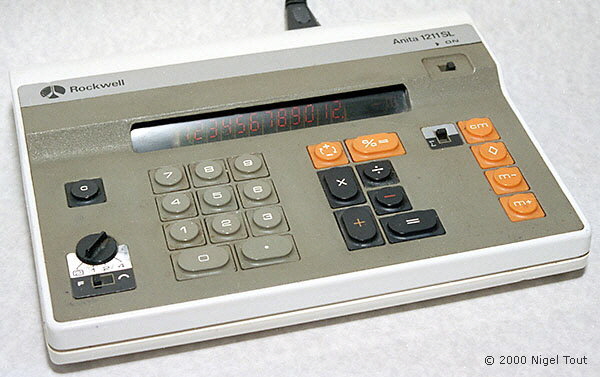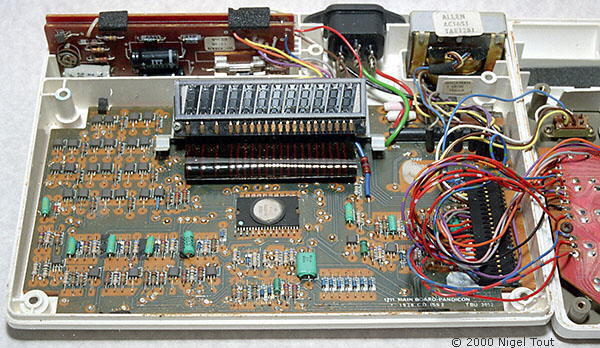Rockwell-Anita Calculators
Rockwell-Anita 1211 SL

Rockwell Anita 1211 SL.
Power supply - AC mains.
Display is 12 digits, amber gas-discharge second-generation 'Pandicon'.
4-function, %, memory.
Integrated circuit - Rockwell A4350PB, here date coded 1975 week 16, and 34 discrete transistors.
220 mm x 168 mm x 50 mm (8.75" x 6.6" x 2").
"Made in England, Electronics Group, Rockwell International. Distributed in UK by Sumlock Anita Ltd.".
The circuit board is marked:
"1211 MAIN BOARD-PANDICON
1976 CD ISS 2 YBU 3052"
The 'SL' in the model name stands for Slim Line.
Note that this model is very similar to a slightly earlier model which is labelled Rockwell Anita 1211, without the 'SL' designation, with circuit board marked:
"1211 MAIN BOARD-PANAPLEX
2028 CD ISS 1 TBU 3051"
That model has a 'Panaplex II' display and other electronic detail differences.

With the casing opened and showing the circuit board, showing the second-generation 'Pandicon' display, the Rockwell A1150PB integrated circuit and many other components including 34 discrete transistors.
The first-generation Pandicon displays were effectively 8 'Nixie'-type assemblies within a single tube as in the Data Devices Brock 880/1 calculator. The Pandicon display in this calculator was a bit of a puzzle at first since it did not resemble the expected construction of a Pandicon. However, a source of 'New-Old-Stock' ZM1500/12 'Pandicon' displays was discovered and it appears that this is a second-generation Pandicon. An example is shown below and matches the display in the Rockwell Anita 1211 SL. In a data sheet it is called a "Planar Pandicon"[1].
'New-Old-Stock' ZM1500/12 'Pandicon' display.
Close up of three characters in the Pandicon display.
At first sight the characters appear to be filament lamps. However the shiny wires are actually electrodes, with the surrounding black metal being the other electrode, arranged as 7-segment displays. These operate in the same way as small neon lamps, so with an applied voltage of about 165v an amber-coloured discharge is generated around the energised wire electrode.
Rockwell-Anita Calculators
Text & photographs copyright © 2002 - 2023 Nigel Tout, except where noted otherwise.